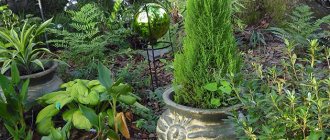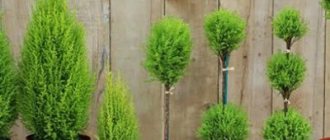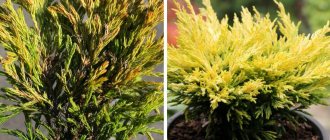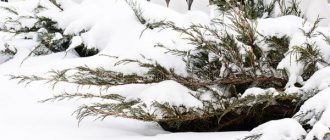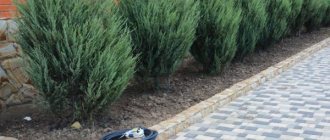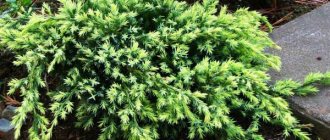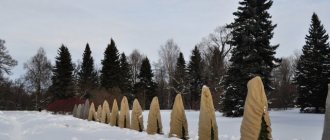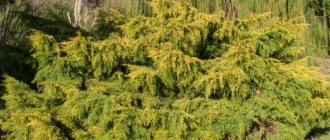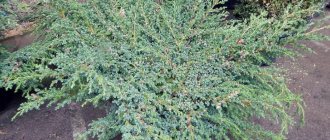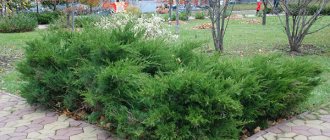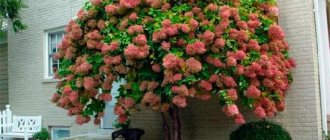What is the difference between juniper and thuja
Both thuja and juniper are representatives of the same Cypress family, which explains their external similarity. These are the most ancient plants that appeared on earth and have survived to this day. In one place, unpretentious plants, with proper care, can grow for centuries. That is why designers paid attention to these conifers.
Thuja and juniper actually have some similarities, so novice gardeners may not always be able to tell them apart. Both evergreens have similar scale-like needles, which have nothing in common with ordinary coniferous trees and shrubs.
If you look carefully at the modified leaves, you can see the difference. Juniper needles remain in the form of needles throughout their life. And the needles of the thuja gradually change, becoming scaly.
Looking at the crown, it is also difficult to immediately figure out where the thuja is and where the juniper is. Thanks to pruning, they can be pyramidal, columnar or spherical. There are varieties of both types of conifers that can be grown not only in the garden, but also in the apartment.
Comparison by position in the taxonomy of the cypress family and distribution in nature
Juniper and thuja are separate genera belonging to the cypress family. Which, in turn, is part of the coniferous plant class. The genus of juniper includes sixty-seven species, the genus of thuja - only five. Some plants, previously attributed by naturalists to the genus Thuja, were later separated into an independent genus of the Cypress family, for example, the oriental flatflower (in Latin Platycladus orientalis).
Branch of young juniper with fruits
The natural habitat of juniper is the Northern Hemisphere from the subarctic regions to the tropics. Thuja is less widespread. The territories where it occurs in the wild are scattered regions of the temperate zone of the Northern Hemisphere. Both plants are unpretentious to the soil, therefore they are widely used in landscaping urban areas and in ornamental gardening. Juniper, in addition, has long been used in the food industry: its ground cones serve as spices in the preparation of various dishes and some alcoholic beverages.
What is the difference between thuja and juniper
To understand which plant to choose for the garden, you need to learn to distinguish thuja from juniper by biological characteristics. We need to talk about them in more detail.
Thuja
Thuja is a tree-like plant and develops very quickly. An adult tree grows up to 6 m, with a girth of about 70 cm. In garden plots, thuja is grown in the shape of a pyramid or a shrub, the branches of which are located in the same plane. The shape of the tree depends on the selected variety. Despite its high frost resistance, no one has yet succeeded in growing thuja in the Far North in open ground.
Thuja can be distinguished by its gray smooth trunk. An old tree's bark changes. Longitudinal fibers appear on it, which peel off in the form of narrow ribbons.
Needles with small scales are pressed tightly against each other. Thuja branches are short, cones 7-12 cm long are formed on them. Each of them, as a rule, contains 2 seeds.
All parts of the plant are useful:
- Thuja needles are rich in resins, essential oils, tannins and flavonoids.
- Seeds are a storehouse of essential oils.
- Thuja wood contains toxifylline and aromadendrin.
Medicinal and homeopathic preparations are prepared from thuja:
- Representatives of oriental medicine have long used parts of thuja for treatment.
- Healers in Rus' healed people from cystitis, prostate, rheumatic pain, and urinary incontinence.
- With the help of medicines prepared from thuja, you can get rid of worms, papillomas, and warts.
- Lubrication with folk remedies based on thuja promotes the resorption of postoperative scars, whitens the skin, and saves it from inflammatory processes.
Juniper
The height of an adult juniper is greater than that of a thuja - this is also one of the differences. Typically, junipers grow up to 7-8 m, and sometimes up to 15 m, depending on the variety. There are also low-growing creeping shrubs. They are used as ground cover plants for landscaping.
Juniper has a trunk with a large number of branches on which there are sharp and hard needles. Each ring contains 3 modified leaves.
In spring, dioecious flowers appear on the plant:
- male inflorescences have the shape of earrings;
- female ones are represented by round cones.
Juniper blooms begin in May, and fruits appear only the next year, late in autumn. These are small berries, the surface of which is covered with a bluish coating. Each berry usually contains 3 seeds.
Attention! Juniper fruits of almost all varieties are edible.
Under natural conditions, junipers can be found in forests, on mountains, in floodplains and swamps. This plant found its way into gardens in ancient times due to its beneficial properties. The ancient Greeks and Egyptians were the first to begin treatment with juniper-based remedies.
Today, medicines are prepared from juniper berries. You can always buy juniper essential oil at the pharmacy. Traditional healers heal their patients using decoctions, tinctures, and syrups. There is no area of medicine in which juniper berries would not have an effect. The fruits are widely used by chefs as a spice for making vodka and liqueur.
What are the benefits of juniper:
- The fruits contain various sugars (40%), resins (10%), essential oils (2%). In terms of acid content (formic, acetic, malic), as well as vitamin C and camphor, juniper fruits are many times superior to other berries.
- The needles contain ascorbic and rhodizonic acid. It is due to them that the bactericidal effect is ensured. The essential oils of this conifer are more powerful than other trees.
Comment! If a juniper forest grows in the area, it can purify the air over an area of 1 hectare.
What is better to plant
If you wish, you can buy a seedling of any shape, but low-growing varieties are in great demand, which are planted in flower beds to contrast with flowering shrubs and ground cover plants.
When deciding what is best to plant and grow in a particular area - thuja or juniper, it is important to take into account not only the design features of the area, but also the preferences of the plants and their differences. The worst possible option is to plant a young plant near a tall tree with a spreading crown that provides abundant shade.
Such a neighborhood will inevitably lead to inhibition of the growth of young conifers.
The lifespan of a thuja is 5 times less, but still very impressive - it grows in one place for about 100 years. Its fruits are practically not used for food purposes, unlike juniper cones, which serve as a valuable seasoning, raw material for medicines, various alcoholic beverages, etc. The price of planting material varies, but on average, thuja seedlings are cheaper, they take root faster in a new place, and are considered a more budget-friendly purchase.
Care for juniper after planting is required for young plants up to 5 years old. Afterwards, you can forget about the need for watering or fertilizing, the plants already have a strong root system. Attention will be required to pruning to give the crown a decorative shape, as well as treatment against pests and diseases (as needed or annually in the spring for prevention). In dry summers, watering is important for thuya at any age.
Very often, conifers are planted in front of the yard to protect the fence and facade from wind and dust. The crown of thujas, especially those planted close to each other, is denser, so they can be used to create an almost impenetrable barrier. You will only need to sprinkle from time to time to wash away the settled dust from the crown. Junipers are shorter growing trees and therefore are not used for such purposes due to their extremely slow growth.
If it is strictly not recommended to plant thuja in partial shade, then such conditions are quite suitable for juniper. If the flowerbed is located near the house - under the windows or near the porch, part of the daylight hours the shadow falls on the crown, then you should not plant the thuja here, it will certainly become deformed over time. On the contrary, such shading will not harm the decorative appearance of the juniper at all. When selecting a planting site, it is also necessary to focus on the shade of the needles: the darker they are, the less their need for bright sun, and light varieties with a variegated (with yellow spots) crown are planted in the lightest area.
The differences between thuja and juniper are quite easy to find, so mistakes when buying seedlings in a nursery are practically excluded. You should base your choice on your preferences, the quality of the planting material and the conditions at the site where the conifers will grow. Both species look very beautiful together, especially tall varieties of thuja in combination with creeping forms of junipers.
https://thedifference.ru/chem-otlichaetsya-tuya-ot-mozhzhevelnika/https://ogorodnash.ru/kak-otlichit-tuyu-ot-mozhzhevelnika/https://lesoteka.com/derevya/kak-otlichit- tuyu-ot-mozhzhevelnika
How to distinguish thuja from juniper
- Common juniper.
- Thuja.
To choose thuja or juniper seedlings and not make a mistake, you need to learn to distinguish plants visually:
- Firstly, conifers have different needles.
- Secondly, they differ in size and height.
- Thirdly, you need to learn to distinguish plants by their cones. Thuja is characterized by oval or oblong cones, on which there are 2 or 6 pairs of scales. And in juniper the fruit is called a coneberry. They are spherical in shape, inside which there are 1-10 seeds (depending on the type).
- Fourthly, plants differ in height and shape: both types can be represented by trees or shrubs.
Attention! Tree-like junipers can grow up to 15 m - this is the height of a 5-story building. Rarely, thujas can reach a height of 70 m and have a trunk diameter of up to 6 m.
Botanical description of genera
Thuja is a member of the Cypress family and has a predominantly shrubby form. Occasionally, tree-like varieties of the crop are also found, and some of them grow up to 20 m in height and boast a crown with a diameter of up to 6 m. At a young age, the leaf blades of the plants are relatively soft, with small needles on the surface, but the older the thuja gets, the more scales there are appears on them.
The culture refers to monoecious plants , with oblong or more oval cones, supplemented by two or six pairs of scales (the uppermost ones are always sterile). The central specimens contain 1-2 or less often 3 flat ovules, supplemented by narrow wing-like growths (there are only two cotyledons). Seed ripening is observed in the fall, already in the first year of cultivation, and this is considered one of the advantages of thuja.
Evergreen juniper (also known as heather) is also related to the Cypress family and can have either a bush-like or tree-like form, but differs from thuja in several main characteristics. The buds of the plant are always bare, not scaly, sometimes framed by shortened leaves pressed against them (for example, in the common juniper).
Rich green leaf blades are arranged in whorls of three, and can have either a needle-like or scale-like surface. They are usually linear-lanceolate, with a descending base and a stomatal stripe in the upper part. There is often a longitudinal midrib in the middle of the leaf, but in general, the leaf blades of young plants are usually needle-like and only with age they become smaller and become scale-like, tightly pressed to the shoots. Single or paired male spikelets are hidden in the axils of leaves or last year's branches.
Video: Types and varieties of junipers
Females are located on axillary, shorter shoots and may have the following features:
- formed by one whorl of scale-like carpels and three straight ovules alternating with them (in some cases the carpels are located opposite);
- have a spikelet with 1–3 pairs of carpel whorls, each of which includes one or two ovules;
- contain one terminal ovule surrounded by sterile scale-shaped carpels.
The juniper cone (the so-called berry-shaped cone) does not open, with fleshy scales tightly pressed to the base. It can have either a spherical or somewhat elongated shape with 1–10 seeds inside. The cone ripens only in the second year of cultivation.
Uses of juniper
Junipers can be placed singly, as tapeworms, or planted in groups at a certain distance. These plants can be included in various compositions with deciduous and coniferous trees, with flowering wild plants.
Experienced gardeners advise growing these conifers in threes, in the form of a triangle. In the lower tier, creeping varieties of junipers can be planted with pyramidal plants.
Trees look great on alpine hills and rockeries. But juniper plants are practically not used as hedges, since junipers grow slowly relative to thuja.
If the site has sliding slopes or slopes, plants can be planted on them to strengthen the soil.
There are many types of juniper that grow horizontally. They are used as ground cover plants.
Thuja in landscape design
Thuja, like juniper, has long been used by landscape designers. These evergreens will enliven any garden not only in summer, but also in winter. With its help, you can create mini-parks (naturgardens), plant trees or shrubs separately.
Tall thujas decorate landscape terraces. Dwarf varieties look great in flower beds, rock gardens and alpine hills. These conifers can withstand low temperatures, so they can be grown in harsh climates.
Arborvitae bushes are great for creating hedges. For this purpose, the following varieties are most often used:
- Brabant;
- Emerald;
- Columna.
Thujas become a real decoration after cutting. The crown can be given various shapes and animal figures can be cut out.
Juniper care
Junipers can be planted both in sunny places and in slight shade. To preserve the beautiful crown and color of the needles, you need to care for the plant, following the rules.
The end of winter and the beginning of autumn can cause sunburn. It's all about the activity of the star. To prevent the needles from burning out, you need to take care of shading during these periods. You can throw burlap or install screens.
Warning! Agrofibre is not the best option for protecting juniper from sunlight, since ultraviolet rays pass through it.
Watering
Newly planted young junipers need to be watered regularly and abundantly, preventing the top layer of soil from drying out. After all, the roots are located close to the surface.
Those trees that are already well rooted, as well as mature plants, do not need watering if the rainy season. In dry and hot summers, pour 1-3 buckets of water under each plant (depending on the age of the conifer). To prevent the needles from drying out, it is necessary to sprinkle.
Top dressing
As for fertilizing, juniper plantings do not particularly need them. You should never feed organics. At first, only young trees are fed at the beginning of the growing season with nitroammophos, potassium nitrate or other complex fertilizer intended for coniferous plants.
Important! Fertilizers are applied in dry form to the tree trunk circle, then watered abundantly.
Trimming
Unlike many garden plants, juniper does not need to be pruned. Although there are varieties, for example, Skyrocket, which without this procedure look unkempt and shaggy. This crop needs to be cut to give it a certain shape.
In early spring and late autumn, the tree needs to be cleaned and damaged and dry branches removed.
Protection from diseases and pests
Juniper practically does not suffer from anything; on the contrary, thanks to its smell, it is able to repel pests from other garden crops.
But it is not always possible to protect plantings from fungal diseases. That is why it is necessary to carry out preventive treatments of juniper with special fungicidal preparations, for example, Topsin-M.
Thuja care
Caring for thuja is easy. After all, the plant is unpretentious. All activities for caring for thuja boil down to watering, fertilizing, protection from diseases and pests.
Watering rules
Thuja is demanding on irrigation; it needs to be regularly watered at the root and sprinkling to wash off dust and protect the needles from burning out. Plan an event for the morning or evening. After watering, you need to remove weeds and loosen the soil.
How to feed
The first feeding of thuja is carried out six months after planting the seedlings. To do this, use ammonium nitrate, urea or special fertilizers for conifers.
Trimming
Thuja needs formative (autumn) and sanitary (early spring, before sap flow) pruning. In addition, you need to remove dried branches and needles inside the crown so that the tree can breathe.
For the winter, both thuja and juniper need to be wrapped with rope, as in the photo.
Landing Features
In Cypress, the growing conditions are almost no different from each other.
Regardless of the shape of the crown, the height of the thuja cypress and juniper plants are planted taking into account the same requirements:
- seedlings are purchased exclusively with a clod of earth so that the roots do not dry out, otherwise the plant will disappear;
- Before planting in a hole, the earthen ball must be watered;
- the planting hole is made larger in diameter and depth than the size of the clod - a man’s palm should be placed between it and the earthen wall;
- when placing the plant in a recess, try to ensure that the root collar is at ground level;
- the air gaps in the pit are filled with a special soil mixture (see table below).
Each plant will feel good if planting is carried out taking into account the requirements of the species.
Individual requirements of Cypress
| Landing Features | Thuja | Juniper |
| Selecting a location | Both sunny and semi-shaded areas | Open, sunny areas |
| Soil for filling the hole | Sand, peat, leaf (turf) soil – 1:1:2 | Sand, turf soil, peat (1:1:2)* |
| Drainage | Broken brick mixed with sand, a layer of 15-20 cm | |
| Planting depth | 60-80 cm | 70 cm (with bedding) |
*When choosing a soil mixture for junipers, take into account varietal characteristics:
- Siberian prefers sandstones;
- Cossack – calcareous soils;
- Virginia - clayey.
Note! Most junipers settle on soils that contain coal. Therefore, it is recommended to add several pieces of this rock to the bottom when planting.
There is not much difference in the process of growing thuja and juniper. Both representatives of the Cypress family need watering in the absence of precipitation for a long time - at least 5 liters of water are needed for each plant.
Feed trees and shrubs once a year, in the spring. During loosening, complex fertilizer is applied to the soil. Regularly ensure that the surface layer of soil is not covered with a hard crust. Conifers need weeding only for the first 2-3 years after planting.
Juniper care
As for pruning, only sanitary pruning is required, which is carried out as necessary in the fall or spring. There are no schemes for regulating fruiting even for junipers. The formation of the crown is carried out solely for decorative purposes.
Diseases and pests practically do not bother conifers. But Cypress trees themselves become good protection for the plants neighboring them.
